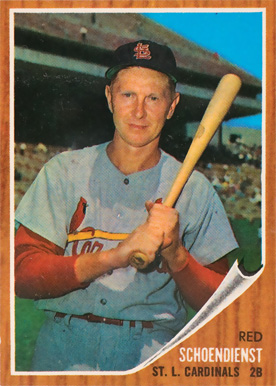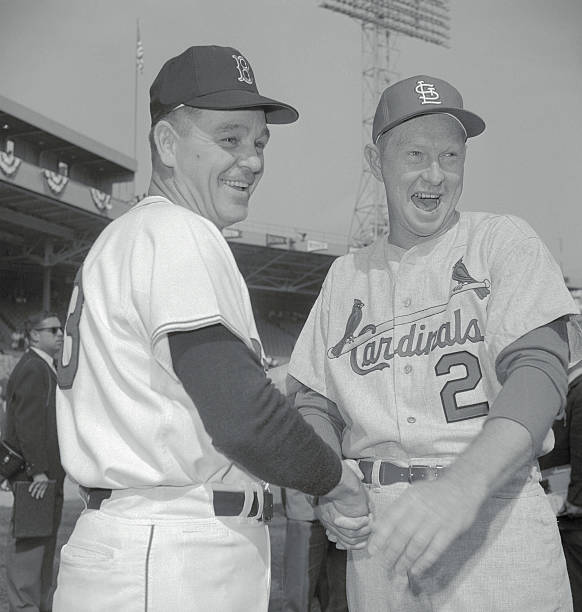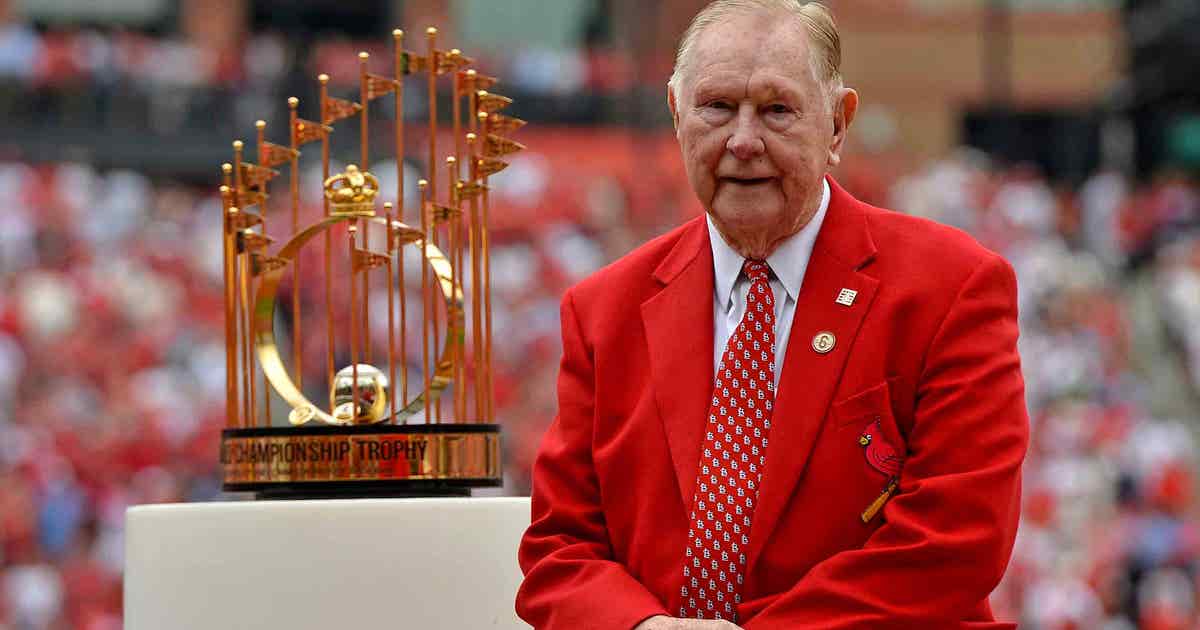Albert Fred Schoendienst was born on February 2, 1923 in Germantown, Illinois, considerably closer to St. Louis than to Chicago. Much of Southern Illinois was then coal country, and his father was a miner. This was before Franklin Delano Roosevelt's New Deal, with its Rural Electrification Administration, and their house not only had no electricity, it had no running water.
Another of FDR's New Deal programs was the Civilian Conservation Corps. Albert, already nicknamed Red because of his hair, dropped out of school at age 16 to join it. But while working on a fence, he was hit in the left eye with a nail. He went through several doctors before finding one who said it could be treated without having to be removed. But he was plagued with headaches for years.
His injury made it difficult to judge pitches, especially breaking balls. So he switched to batting lefthanded. The St. Louis Cardinals signed him in 1942, and had gotten up to Triple-A before being drafted into the U.S. Army in 1944. The Army soon realized that, with his eye injury, he was not fit for combat, and he was medically discharged, allowing him to play in the 1945 season.
A natural shortstop, he would have been stuck behind the best shortstop in the National League at the time, Marty Marion, a man known as the Octopus because his fielding suggested that he had 8 arms. So Red was put in left field, then moved to 2nd base in 1946. It was the Cardinals 4th Pennant and 3rd World Championship in a span of 5 years, but, in each case, it was Red's 1st.
In 1950, he handled 320 consecutive chances without an error, and hit a home run in the top of the 14th inning to win the All-Star Game for the National League, 4-3 at Comiskey Park in Chicago. In 1956, he had a fielding percentage of .9934, a record for 2nd baseman that stood for 30 years, until broken by Ryne Sandberg.
In that 1956 season, the Cardinals traded him to the New York Giants. In 1957, the Giants traded him to the Milwaukee Braves for Bobby Thomson (yes, that Bobby Thomson) and 2 others. That trade was key to the Braves winning their 1st Pennant and 1st World Series in Milwaukee, as Red batted .309 and finished 3rd in the Most Valuable Player vote, behind his new teammate Hank Aaron and his former teammate Stan Musial.
Still, he doesn't look right in any uniform
other than that of the Cardinals, does he?
The Braves won the Pennant again in 1958, but blew World Series leads of 2-0 and 3-1 to lose to the Yankees in Game 7, which ended with Red flying out to Mickey Mantle in center field. During the off-season, he was diagnosed with tuberculosis. It seemed as though he would never play again.
But he returned in 1960, and was reacquired by the Cardinals in 1961, batting over .300 in a pinch-hitting role in both 1961 and 1962, before retiring to the coaching staff in 1963. He finished his career with a .289 batting average. He would be elected to the Hall of Fame as a player in 1989.
*
But most people remember him better as a manager. He was on the Cards' coaching staff when they beat the Yankees in the 1964 World Series. Right afterward, manager Johnny Keane resigned, and Red was appointed to replace him.
This was the 1st MLB team to mix white, black and Hispanic players in large numbers and win the World Series. The Brooklyn Dodgers had a couple of Latin players in the 1950s, and the San Francisco Giants won a Pennant doing this in 1962, but the Cards -- with bad grammar in English and Spanish, nicknamed "El Birdos" -- went all the way. In 1967, Red led them to the Pennant, and beat the Boston Red Sox in the World Series in 7 games. In 1968, he led them to another Pennant, but lost the World Series in 7 games, to the Detroit Tigers.
With Dick Williams, manager of the Red Sox,
at Fenway Park during the 1967 World Series
Red continued to manage the Cards until 1976, getting them into the NL Eastern Division race in 1973 and 1974 before fading. He remained on the Cardinals' coaching staff, and was interim manager in 1980 between the firing of Ken Boyer and the hiring of Whitey Herzog, and again in 1990 between the firing of Herzog and the hiring of Joe Torre. Overall, his managerial record was 1,041-955. He won a 5th World Series ring as a Cardinal coach in 1982. Interestingly, all 5 were in Series that went the full 7 games: 1946, 1957, 1964, 1967 and 1982. He was also a member of 4 teams that lost 7-game Series: 1958, 1968, 1985 and 1987.
In 1996, the Cardinals retired his Number 2. In 1998, he was inducted into the St. Louis Walk of Fame. In 2006, when the current version of Busch Stadium opened, Red was among the honorees, all with retired numbers, who had a statue dedicated outside. In 2014, he was a charter inductee into the St. Louis Cardinals Hall of Fame Museum. In 2015, he was inducted into the Milwaukee Brewers Walk of Fame at Miller Park, although he played for the Braves, not the Brewers.
He was married to Mary O'Reilly for 52 years, until death did they part. They had 4 children, and he lived to see 10 grandchildren and 7 great-grandchildren. He also lived to be the oldest living member of the Hall of Fame, the last surviving player from the Cardinals' 1946 World Champions, and the oldest and earliest living manager of a postseason, Pennant-winning or World Series-winning team.
He also set a record that is unlikely to be broken: 74 consecutive seasons wearing a Major League Baseball uniform. 67 of them were spent with the Cardinals. What Phil Rizzuto was to the Yankees, Johnny Pesky to the Red Sox, Richie Ashburn to the Philadelphia Phillies, and Tommy Lasorda to the Dodgers, Red was to the Cardinals: A living link to more than one glorious era, and elderly reminder of all that the team stood for, a living legend.
At Busch Stadium at last year's 50th Anniversary
celebration of the 1967 World Championship.
He's posing with the Commissioner's trophy awarded then.
It was the 1st time the Trophy was awarded. Note 20 flags for 20 teams.
Until he could live no more. Red Schoendienst died on June 6, 2018, at his home in the St. Louis suburb of Town and Country, Missouri. He was 95 years old.
With his death:
* There are now just 31 men who are living veterans of both World War II and Major League Baseball: Cloyd Boyer, Bobby Brown, Fred Caliguiri, Dick Cole, Jack Crimian, Billy DeMars, Carl Erskine, Johnny Groth, Chuck Harmon, Don Hasenmayer, Chris Haughey, Val Heim, Johnny Hetki, Lefty Howard, Randy Jackson, Howie Judson, Dick Manville, Ed Mickelson, Larry Miggins, Bob Miller, Fenton Mole, Bobby Morgan, Irv Noren, Eddie Robinson, Frank Saucier, Bobby Shantz, Charlie Silvera, Paul Stuffel, Wayne Terwilliger, Wally Westlake and George Yankowski.
* The earliest living winner of a World Series is Bobby Brown of the 1947 Yankees, age 93.
* There are 18 living former New York Giants: Terwilliger, Willie Mays, Bill White, Johnny Antonieelli, Jackie Brandt, Eddie Bressoud, Pete Burnside, Foster Castleman, Gil Coan, Ray Crone, Billy Gardner, Harvey Gentry, Joe Margoneri, Mike McCormick, Ron Samford, Ozzie Virgil Sr. and Al Worthington.
* The earliest living manager of a postseason team, or of a Pennant winner, is Lasorda, age 90. So we went from 1967 to 1977 in one fell swoop. The earliest living manager of a World Series winner is also Lasorda, so that's a jump from 1967 to 1981.
* The earliest living manager of any team is Alex Grammas, 92. Best known as Sparky Anderson's 3rd base coach on the 1970s Cincinnati Reds, he managed the Pittsburgh Pirates for the last 5 games of the 1969 season, and also managed the Milwaukee Brewers in 1976 and '77.
* And the oldest living member of the Baseball Hall of Fame is Lasorda. The oldest living person elected as a player is Yankee Legend Whitey Ford, 89.
UPDATE: Red Schoendienst was buried at Resurrection Cemetery in the St. Louis suburb of Affton, Missouri.




No comments:
Post a Comment